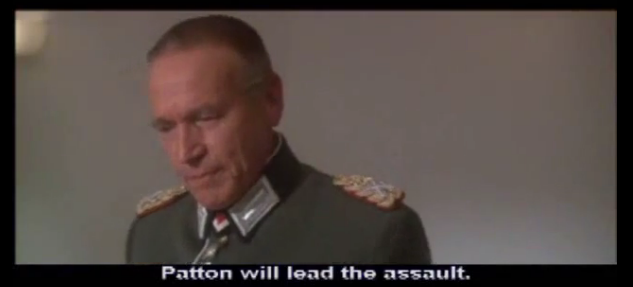
Posted on 03/10/2013 6:59:35 PM PDT by JerseyanExile
A Bridge Too Far is one of my favourite war movies. Pretty much the last of the Big Screen Epics, with an All Star Cast, it doesn’t try to do much except simply tell what happened. No romantic sub plots, no political commentary, it just goes all-out to bring us the story. There’s a scene near the beginning, where von Rundstedt and Model are discussing if they need to worry about stopping Patton or Montgomery.

“He’s their best. I’d prefer Montgomery, but Eisenhower isn’t that stupid” says von Rundstedt. The whole Monty/Patton argument in general is frequent, and shows up even in the Hatch forum (See the El Alamein thread).
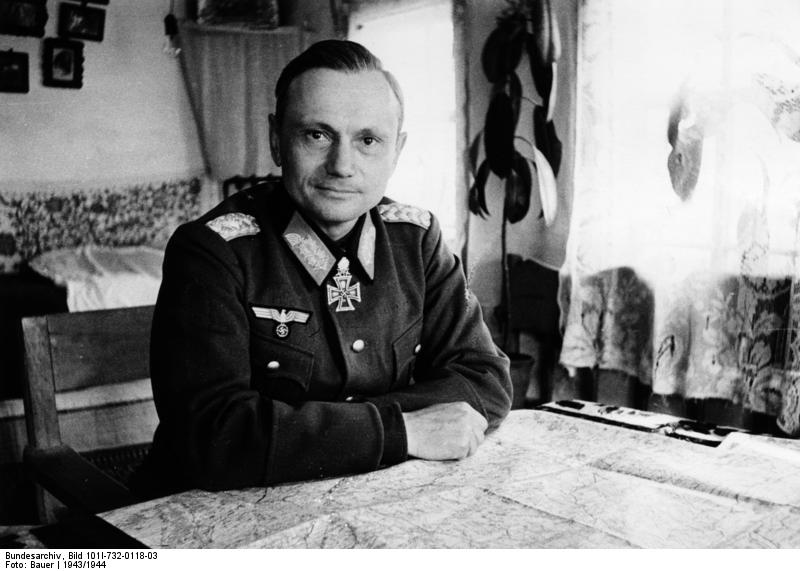
Now, this handsome fellow was a chap by the name of General der Panzertruppe Hermann Balck. By most accounts he was quite a competent chap, probably one of the best Panzergenerals the Germans had to offer. It is doubtful that many officers could have performed as he did in the Eastern Front. The Autumn of 1944 saw him in command of First Army, in central France. He had some issues to deal with. In a letter he wrote to von Rundstedt, he said “I have never been in command of such irregularly assembled and ill-equpped troops.” Certainly the German Army in October 1944 was not the same as it had been in 1941. His next sentence, however, bears some attention: “The fact that we have been able to straighten out the situation again and release the 3rd Panzergrenadier Division for the Northern front can only be attributed to the bad and hesitating command of the Americans and the French…” Later he said “Within my zone, the Americans never once exploited a success.” The unit facing him was US Third Army, the bad and hesitating commander he referred to turned out to be this fellow.
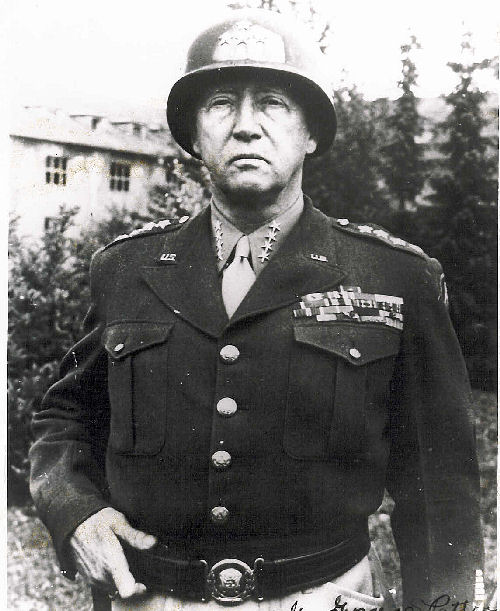
Yep, it’s George S. Patton Jr, the US’s best tank general of WWII. What’s going on?
When he was over to partake in Operation Think Tank, Harry Yeide gave me a copy of his new book, “Fighting Patton.” I love books like this. He completely ignores preconceptions, that which we know to be true simply because everybody knows it, and digs down to find the verifiable truth for himself. He said he was watching the movie “Patton”, and was intrigued by the German intelligence officer who kept the historical bio of the man. In this case, Yeide almost completely ignored the US writings, and instead went straight to the German war records and diaries of the people facing Patton to see what –they- were saying. It makes fascinating reading and throws a number of our preconceptions on their heads.

Now, I have somewhat mixed feelings about General Patton. The US Army has seen fit to name its museum of leadership after him, but while he may have been a great leader, I (please ignore the soap box under me) have something of a belief that his style of leadership belongs in a museum and there may be better role models for today’s young officers. The authoritarian style is something of an anathema to what I have seen work, but then, I work with 21st Century soldiers, not ones from 1940s. For current purposes, my opinion on this is irrelevant: What counts is what 1940s Patton did with his 1940s soldiers against 1940s Germans, Italians and French. Well, he led them to victory. What's interesting, though, is the perception of how he did it and of what people thought of him.
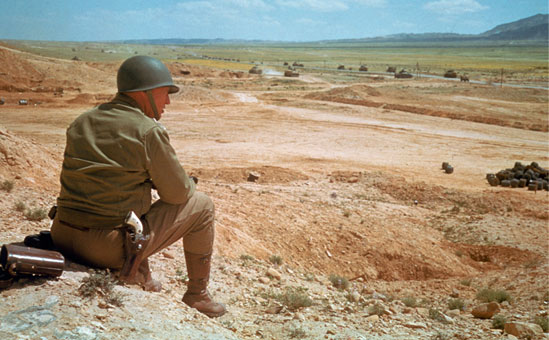
By and large in North Africa, the Germans not only had no clue who this Patton fellow was, they pretty much didn’t care anyway. The records show that their focus was Montgomery, the forces in the West facing the Americans basically had to work with whatever the Axis forces had to spare after taking Montgomery into account. Who the American commander was was somewhat irrelevant to them. Move to Sicily, and the great dash to Palermo didn’t impress the Germans either: They had voluntarily abandoned the territory. The reason why Montgomery was slow while Patton was able to loop around the island at high speed? The Germans had moved all available forces from the West to stop Montgomery, they didn’t care about the West of the island. After all, their escape route was to the East. And then they discovered, to somewhat their surprise, that the Allied advance was so hesitant that they were able to get most of their men and heavy equipment off the island, which they hadn’t thought would be possible when they started the Sicily defence. The name “Patton”, however, still didn’t seem to mean much to them.
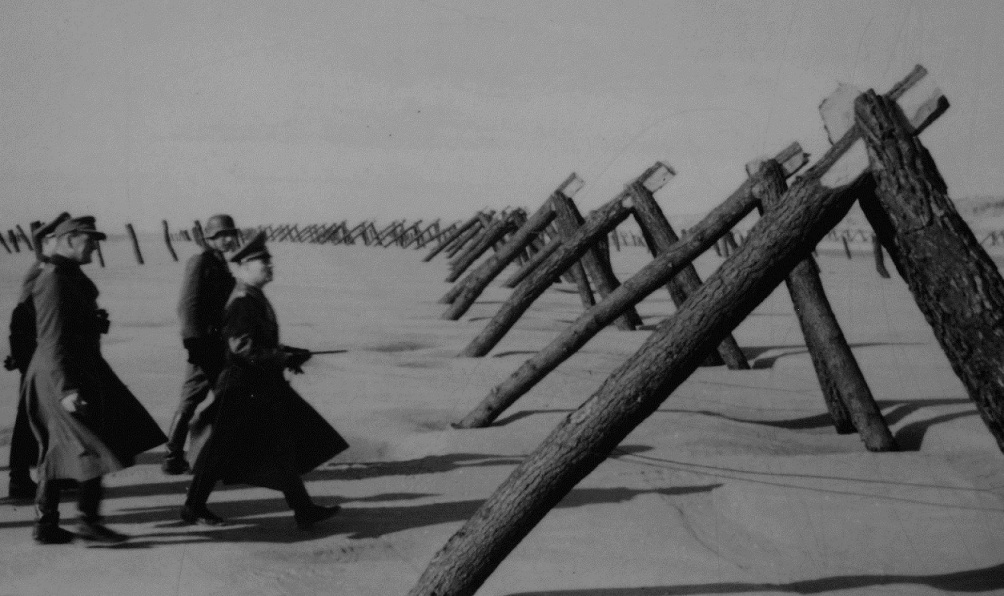
Ok, we move on. Patton is beached for a while, as we know, and then put in charge of FUSAG, the fictional unit supposed to invade the Pas de Calais. The common story is that the Germans were so in awe of Patton that they were convinced that wherever he was, that’s where the main invasion would be, and that may have been the intent. Problem seems to be that most German officers had never heard of the man at that point. Just because the US newspapers or General Eisenhower may have thought the Germans feared Patton doesn’t mean that the Germans felt the same way! That they were worried about FUSAG is pretty much a given, but they were worried about a supposed huge body of men and equipment. It could have been commanded by General Snuffy, as far as they cared. When he does move to the continent and takes over the US Third Army, the Germans had already decided to withdraw to the German border, and the race across France actually took about four weeks longer than the Germans had anticipated it would. And while they were doing it, the primary focus of the Germans was, again, Montgomery. Units facing Bradley (and thus Patton) generally had to make do with what was left over. There seems to have been no "Patton Panic" in the German Army.
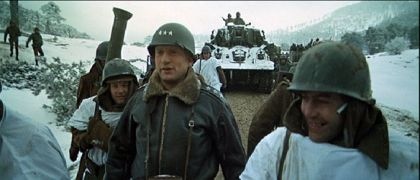
There’s a scene in “Patton” where the various allied officers are having a chat with Bradley about the German Ardennes offensive. Patton (George C Scott, of course) stuns the assembled men by announcing that he can have elements of his Army make a left turn and head for Bastogne in three days. All very impressive. German records for the planning of the Ardennes expedition indicate that they expected an attack from the South a little faster than that. And by the time Patton had actually gotten his forces to the fight, the German offensive was already considered a lost cause by the Germans. The commander of the forces which actually stopped the offensive? Field Marshal Bernard Law Montgomery overall, and General Courtney Hodges with his First Army in particular.
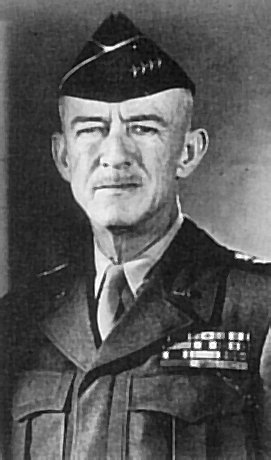
Now, I’m going to go off-track for a second here. Whatever the merits of Patton, Hodges is someone who probably deserved to have a movie of his own. He joined the Army as a private only three years before Patton commissioned as a lieutenant, yet was his equal under Bradley in the French campaign. His First Army undertook some of the most significant fighting of the Western front, but it seems that few people have even heard of him. If you get the opportunity, he might be worth a little personal research. To a large extent, this demonstrates the folly of the Monty/Patton argument: In France, Montgomery and Patton were not even competitors, except perhaps for press coverage. Montgomery’s counterpart was Omar Bradley, Patton’s counterparts as Army commanders were Hodges, Simpson, and Gerow. How many Patton/Hodges arguments are there on the Internet?
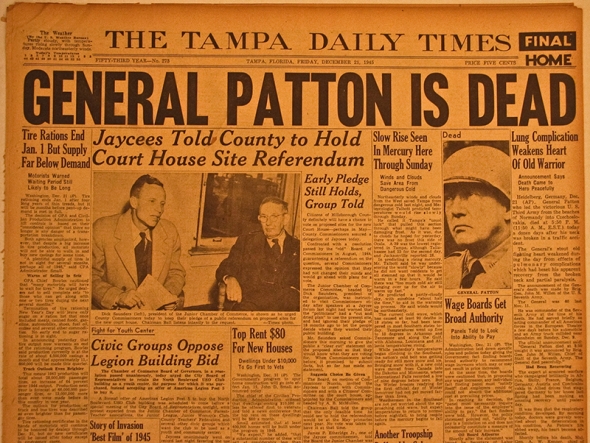
Now, I’m not saying that Patton didn’t have his good points. When he knew he was free to advance, he did so with a speed that few could, or would, match. His philosophy of offence above all else is matched by some of the most successful generals out there (although, granted, it worked for Custer as well during the US Civil War, and we know how that ended up afterwards), and he was a senior commander on the winning side so he must have had merit. “Fighting Patton” is a 500-page opus, almost 20% of which is supporting notes and references, and Yeide reports both the praise that the Germans gave Patton as well as their criticism. It really is worth the read. Fundamentally, Patton was the US Army’s best tank general in WWII in a field of… erm… Quick! Name a US ‘tank general’ in WWII other than Patton? And to crown off the mythology and seal his fame, he died tragically. That, colorful and competent, there’s little wonder he’s the US’s most famous general of the time, if not ‘ever.’ To the Germans, though, he was pretty much just another general, not anyone to take really significant note of.
The point of this all, though, is one which I try to make repeatedly. Take conventional wisdom with a grain of salt. For example, there’s nothing wrong with being slow and methodical as a commander when you can afford to be, a trait commonly associated with Montgomery. Which is fortunate, because that’s how a good number of German officers described their opposition, which turned out to be Patton. (“Hesitant “and “missing opportunities” was another common description, mind). And, of course, Patton never faced the ultimate test of conducting a fighting withdrawal. We know that Patton was a commander worthy of praise, the Germans credited him for it when they felt it was deserved. But Harry Yeide went further, took the initiative and effort to challenge the “US side of the US story” and look into the background, only to reinforce that the truth as we know it may not be the whole truth. Good for him, and may he continue.
My neighbor served with General Patton, and has a couple of photos of the two of them.
Thanks to Henry Ford and his industrial genius in creating assembly line manufacturing we could crank out tanks, planes, mechanized vehicles beyond anything our enemies and allies could do.
Although I suspect he had mixed feelings about them defeating Nazi Germany.
“My father was attached to Patch’s Army”
My 93 yr old father also served in Patch’s Army, in a AA battery assigned to the Corp HQ. Actually dad also served under Patton until Alexander Patch took command of the 7th. Patch was a very good general. Little known because he didn’t cultivate the press, and the 7th Army’s campaign didn’t involve Normandy.
Dad has told me that the men he served with preferred Patch. Patton could be petty, for example ordering medical personnel to wear steel pots when they were far from the front. All that this accomplished was to make their job of attending to the wounded more difficult.
A family friend of ours had been a young German POW. At the end of the war Patton selected him out of a POW camp to clean his riding boots and perform similar chores. He was actually treated quite well by Patton, other than the time that Patton found some dirt remaining in the wedge of a boot heel and threw the boot at him. “Dirty!” Patton yelled.
Years later dad served with one of Patton’s sons, a Colonel, in Vietnam. He says the son was one of the finest officers he served with in his career in the Army.
“Sherman tanks to equip their elite Guards Tank Divivions”
Only until such time as their productive capacity improved to the point where the T-34’s became primary. I saw a number of T-34’s at the Ukrainian War Memorial in Kiev. They are the roughest looking thing going because they had to be built fast with no “finish” on them.
When the Russians finally turned the tide against the Germans, the T-34 was their lead. That is the tank that won at Kursk.
You’ve got your history backwards. The Lend-Lease Sherman tanks were a later replacement for the T-34 tanks. The Lend-lease Sherman tanks were delivered to the Soviet Union during the period of 1943-1945, and the Red Army used them as a high reliability replacement for the T-34. Among the early deliveries were some 38 of the M4-A2 Sherman tanks equipped with the Diesal engines used by the 229th Tank Regiment, 48th Army at the Battle of Kursk. As further deliveries of the Sherman tank arrived, they were used to equip the Red Army’s elite tank units for the remainder of the Second World War, and the more than 4,000 Sherman tanks comprised some 16% of Soviet tanks during the war or one in six Soviet tanks. The Soviet Sherman tanks were highly valued by the Red Army to the end of the war where they participated in large numbers on the Soviet-Japanese front in 1945.
The Sherman tanks were also highly effective against Soviet T-34/85 tanks in the Korean War, where the Sherman was in half of the tank to tank engagements, killed 3 to 1 in loss rate, and very few of which became unrecoverable or unserviceable. On average only one crewman was killed wheen a Sherman was knocked out, whereas on average only one crewman survived when a T-34 tank was knocked out. This survival rate, improved habitability, being equipped with a tactical radio, good performance, superior ease of maintenance and reliability combined to make the Sherman a first choice of tank in the Red Army.
When dad was near Munich he befriended a young Russian who was held as a POW by the Germans. Oh, how he hated them. He spoke fluent German and was used by my father and some others a an interpreter. They called him “little Joe” and even took up a GI uniform to fit him. He wore the uniform when they were on patrol.
My father considered adopting him and bringing him to Texas when he returned. He talked to the CO about it but did not, he was concerned that the war so hardened him that he might be a problem. His CO was receptive to the idea.
When I was a young man he told that I almost had another brother and then about “Little Joe”. He has often wondered what became of him.
—
Patton detractors had best avoid the subject in Dad’s presence.
Was the about Lt. Jack Bushyhead after the liberation of Dachau?
One account:
http://www.scrapbookpages.com/DachauScrapbook/DachauLiberation/BuechnerAccount.html
My father’s company was encamped near Munich and he spent part of the winter after it was liberated guarding German POW labors who cut the forest there for firewood. Some of those POWs were SS. They were normally identified with a tatoo. One of them was an SS doctor, they used the term loosely.
Stalin blackmailed the Western Allies into forcibly repatriating Russians, Ukranians, and others in exchange Anglo-American and other Western Allied POWs detained by the Soviet forces as bargaining chips. Stalin ordered these repatriated POWs to be shot after they debarked from the transport ships at the Crimean docks. Allied officers raged in vain as this happened. When the U.S. refused to continue these reppatriations, thousands of American detainees were allegedly disappeared into the Soviet gulags.
“The Germans called the Sherman tank “the Ronson”, because one hit and it would blow up and catch fire.”
The anecdote misrepresents the larger truth. All medium tanks had a tendency to burn like a lighter when penetrated by the AP rounds of a heavy tank or another medium tank. The M4 Sherman was designed and built as a medium tank capable of defeating 1942 era medium tanks and anti-tank weapons. By the time the M$ was widely deployed in the ETO, Germany and the Soviet Union supplemented their tank forces with heavy tanks and larger caliber anti-tank weapons capable of defeating the M4 armor. Nevertheless, the M4 proved to be quite capable of matching the vast majority of threats it faced, particularly the most numerous German medium tanks, Panzerkampfwagon II/IV, and smaller caliber anti-tank weapons. Even the German heavy tanks proved vulnerable at the typical ranges actually fought in the tank against tank engagements. While there were some occasions where one Tiger tank knocked out nine M4 medium tanks in one engagement, there are also other engagements where the reverse situation occurred with the Shermans knocking out a succession of Tiger tanks. Due to the relative rarity of the German Tiger and Panther tanks versus the German medium tanks, the Shermans rarely engaged them in tank against tank battles. When they did find themselves in such engagements, the Shermans did reasonably well and the disparagement of their lesser guns, 75mm and 76mm high velocity, are not justified when seeing the actual numbers of engagements and tanks knocked out.
“The mechanics of the Sherman were very good. But the tank was underarmored and undergunned especially against heavier German equipment.”
The Shermans were never meant to enter such engagements, and when necessity required them to do so their results overall were fair to good. The heavier armament and armor versus the lesser numbers and lesser availability due to maintenance left the Sherman in control by virtue of numbers and by virtue of defeating the heavier armament in most engagemens..
Arguably the best tank of WW-2 was the Russian T-34, which was diesel, heavier gunned, very fast and was the first to make use of sloped armor, which greatly improved protection.
The T-34 tank had less armor than the Lend-Lease Soviet M-4/A2 Sherman tank, so the superior sloping of the glacis was necessary to give the T-34 slightly improved technical protection. Unfortunately, the T-34 theoretically better frontal protection did not translate into better protection in actual combat. When knocked out, the M-4 tank crew on average suffered one crewman killed, bu the T-34 crew experienced the opposite result with only one crewman surviving the knockout. This survivability improvement, reliability, simplified maintenance, tactical radio absent in the T-34, and many other attributes made the M4 a favorite among the soviet tank regiments.
Life is cheap to a Commie B_tard.
Until it is his.
Totalitarianism in all it’s forms is evil.
I think what most concerned the Germans about Monty was the fact that his Army Group was fighting on the Northern European Plain, while Patton and the other American Armies were on the Allied right fighting over the rougher terrain of the interior. While having Patton on the right flank spearheading the breakout from Normandy was effective, it led to Third Army being in a bad position for leading the way to Berlin. If I were a German general, I would be more concerned with the forces on the flat ground closest to my capitol than the ones in the south where the natural and man-made obstacles were greater. I have wondered what would have happened if Eisenhower had been able to somehow shift Patton to the north so that Third Army would have had better terrain for rapid movements with armored formations. “What if” scenarios like that will keep armchair generals occupied for centuries.
Pound for pound, I'd take the Panzer V Ausf G with that high-velocity 75. Of course, your ten T-34s to my one Panther would leave me a burning wreck but I'd take a few of yours with me :)
The Panther had a direct influence in the designs of both the Soviet IS-2 and the American M26 Pershing and was used, in quantity, by the Soviets themselves when captured.
Yep. As a guy with the 42nd Division [our General Linden accepted the surrender at Dachau] we were anticipating that the Nazi redoubt would be in Bavaria. It wasn't, so the scenarios continue.
My regiment was in reserve so I did not get to Dachau, we went to Munich. The war was not over yet.
“Patton and the other American Armies were on the Allied right”
Patton’s U.S. Third Army and the 12th Army Group were in the Allied center position. The Allied right flank position was occupied by Dever’s 6th Army Group with the U.S. Seventh Army and French Army B (later First French Army).
So long as there were any British field armies involved in the military campaign, there was zero chance the left flank position in the region of the lower Rhine would be occupied by any other than a British army or army group performing its traditional role. This perforce left the traditional invasion route into Germany through the center position to an American army group using its traditional line of communications through Cherbourg, Bordeaux, and/or Marseilles. In this case it became Cherbourg and Marseilles.
Knowing these geographical constraints, Patton had prepared himself decades before the Second World War to command an army in France. He studied the military histories pertaining to military campaigns and invasion routes through France. He and his wife used their early automobile to tour through the Norman and other French countryside, so Patton could study the terrain, roads, and bridges for their future military value in the event of an American military campaign through Frrance and into Germany. It is this kind of personal preparation which made it possible for him to command the Third Army while other officers were still preoccupied with the uncertainties they faced using just the map studies and aerial reconnaisance photos. It is the reason why he was able to wade out in the river to demonstrate the water was low enough to ford while the officers of the maneuvering unit were stalled at the river and wasting time trying to figure out whether or not there was a safe place to ford the river in the face of German positions on the overlooking ridge on the other side of the river.
Well, that was completely ludicrous. Third Army had its supplies curtailed ahead of Market Garden (which was one of Monty’s ridiculous fiascos, as was the Falaise Gap, which has often been blamed on Patton) and kept its motors running on “liberated” gasoline. October also had the First Army et al engaged in the battle of Aachen. Patton kept stocking up from the trickle of supplies, and was given the go early in November.
Here’s Balck, who had some moderate success at not being a miserable failure:
http://en.wikipedia.org/wiki/Hermann_Balck
Disclaimer: Opinions posted on Free Republic are those of the individual posters and do not necessarily represent the opinion of Free Republic or its management. All materials posted herein are protected by copyright law and the exemption for fair use of copyrighted works.